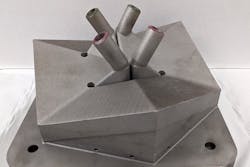3DP Credited for Advanced Heat-Exchanger Development
General Electric researchers have designed, produced, and tested a 3D-printed heat-exchanger for turbine engines, both jet-propulsion engines and industrial gas turbines. The subscale model is the result of a $3.1-million project begun in 2019, led by GE Research through the U.S. Dept. of Energy’s Advanced Research Projects Agency’s (ARPA-E) High Intensity Thermal Exchange through Materials and Manufacturing Processes program (HITEMMP).
The effort also includes researchers at the University of Maryland and DoE’s Oak Ridge National Laboratory. The goal is to develop a “high temperature, high pressure and super-compact heat exchanger” for clean and more efficient power generation.
“Being able to run power turbines and jet engines hotter translates into higher efficiency levels,” according to GE Research.
A separate GE business unit, GE Aviation, was an early adopter of 3D printing/additive manufacturing technologies among OEMs, including some high-volume jet engine components. Another GE business, GE Additive, develops electron-beam and laser-based 3D-printing technologies and produces parts in specialty alloys for aerospace and biomedical manufacturers.
The GE Research subscale, demo-version heat exchanger was tested at temperatures that the project’s goal of 900°C (1652°F) and achieves close to half the 250 bar (3626 psi) target pressure. For comparison, this exceeds by more than 200°C, or close to 400°F, the operating performance of the most-effective heat exchangers in use today.
Lana Osusky, a GE Research lead engineer, noted the effective design – comprised of multiple thin-walled cells, resembling a bunch of grapes – is able to handle the higher temperatures and pressure sought by the researchers. She credited the development to material and design capabilities available via additive manufacturing.
“The design freedom afforded by 3D printing processes and design tools is allowing us to more rapidly develop, build and test new heat exchanger designs that were previously not possible,” Osusky stated. And she noted that the GE-led team is on track to build and test its final prototype at full temperature (900°C (1652°F) and pressure (3,626 psi) by the close of the project in Q1 2022.